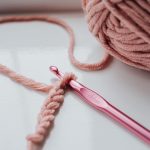When it comes to organizing your fabric collection, you've likely noticed how a cluttered space can stifle creativity. By taking the time to assess your stash and implement a few strategic storage solutions, you can create an efficient system that not only saves time but also sparks inspiration. Consider how sorting by color and pattern can transform your workspace, making it easier to find exactly what you need. But there's more to effective organization than just sorting—let's explore a few essential tips that will elevate your crafting experience.
Table of Contents
Key Takeaways
- Gather all fabric in one place to assess quantity, type, and condition before organizing.
- Utilize clear containers for visibility and easy access, labeling each with fabric details for quick identification.
- Organize fabrics by color and pattern to create an inspiring and visually appealing storage space.
- Implement a regular inventory management system to track fabric details and avoid duplicates.
Assess Your Fabric Collection
Before diving into organizing, have you taken a good look at your fabric collection to see what you really have?
Assessing your fabric stash is the first step towards effective organization. Start by gathering all your fabric in one place. This way, you can see exactly what you're working with, making it easier to identify duplicates or pieces you no longer love.
As you sort through your collection, take note of the types, colors, and sizes of fabric you own. This assessment helps you realize what you use frequently and what's just taking up space. Consider creating categories: cottons, silks, knits, and upholstery fabrics, for example. This'll make it simpler to find what you need later on.
Don't forget to check for any fabric that's damaged or stained. If it's beyond saving, it's time to let it go. You might also discover some hidden gems you forgot about!
Assessing your fabric collection not only clears your space but also sparks creativity. By understanding what you have, you can make better choices for your next project and maximize your crafting potential.
Choose the Right Storage Solutions
Choosing the right storage solutions is essential for keeping your fabric organized and accessible. Start by evaluating your space and how much fabric you have. If you've got a small collection, a simple shelving unit or decorative bins might work perfectly. For larger stashes, consider clear plastic containers or dedicated fabric cabinets, as they allow you to see everything at a glance.
Think about how often you use different fabrics. If you work with certain materials frequently, keep them within easy reach. Use drawers or shelves at eye level for those, while less-used fabrics can go higher up or in less accessible spots. Labeling containers can also help you quickly identify what you need.
Don't overlook vertical space! Wall-mounted racks or pegboards can be great for hanging fabric rolls or small bolts. If you've got limited floor space, think about using a rolling cart. This way, you can move your fabrics around easily.
Lastly, maintain your storage solution. Regularly reassess your needs and adjust your organization as your fabric collection grows or changes. This proactive approach will keep your creative space clutter-free and inspiring!
Sort by Color and Pattern
Sorting your fabric by color and pattern can significantly enhance both the organization and visual appeal of your collection. When you group fabrics by color, you create a vibrant display that makes it easy to find what you need for your projects. Start by selecting a color palette that resonates with you—whether it's bold and bright or soft and muted.
Next, within each color group, consider organizing by pattern. You might choose to separate solids from prints, or arrange prints by type, such as florals, stripes, or geometric designs. This method not only streamlines your search for specific fabrics but also helps you visualize how different pieces might work together in your projects.
As you sort, take a moment to fold each piece neatly; this will keep them looking their best and prevent wrinkles. You may also want to consider labeling sections or bins according to the colors and patterns you've chosen. Not only will this make it easier to maintain your organization over time, but it'll also inspire creativity as you see all your beautiful fabrics displayed together.
Happy sorting!
Utilize Clear Containers
Using clear containers is a smart way to keep your fabric organized and visible.
You'll want to explore different types of containers, consider how labeling can simplify access, and discover stackable solutions that maximize your space.
Let's break down these key points to help you create an efficient storage system.
Types of Clear Containers
When it comes to organizing fabric, clear containers come in various styles and sizes to fit your needs perfectly. You can choose from stackable bins, which maximize vertical space, to smaller boxes that are ideal for storing scraps or specialty fabrics. If you're working with larger pieces, consider using wide, shallow containers that allow easy access and visibility.
Another option is tote bags or fabric storage bins made from clear plastic. These are great for transporting your fabric to classes or sewing meet-ups, while still keeping everything visible. For smaller items, like threads or notions, small clear jars or compartmentalized organizers work wonders, letting you see everything at a glance.
Don't forget about drawer organizers! They can help you keep your fabric neatly arranged within drawers, preventing it from becoming a jumbled mess. Plus, clear containers often come with lids, keeping dust and moisture at bay.
Labeling for Easy Access
To make the most of your clear containers, labeling them can significantly enhance your ability to find fabric quickly and efficiently. When you can see what's inside at a glance, it saves you time and frustration.
Here are some effective tips for labeling your containers:
- Use a label maker: This creates neat, professional-looking labels that are easy to read.
- Color-code labels: Assign different colors for specific fabric types or projects, making it visually appealing and easy to differentiate.
- Include fabric details: Mention the fabric type, yardage, or even a project idea to jog your memory.
- Update regularly: As you acquire new fabrics or finish projects, keep your labels current to avoid confusion.
With these strategies, you'll find it much easier to access your fabric stash, allowing you to focus on what you love most—creating beautiful projects.
Stackable Storage Solutions
Maximizing vertical space with stackable clear containers not only keeps your fabric organized but also makes it easier to see your entire collection at a glance. Clear containers allow you to quickly identify colors, patterns, and textures without having to dig through piles. This saves you time and reduces frustration when you're in the middle of a project.
When choosing stackable containers, look for options that are sturdy and designed for easy stacking. Consider different sizes to accommodate various fabric pieces, from small scraps to larger cuts. Don't forget to keep similar fabrics together—group cottons, silks, and knits for a more organized system.
Labeling each container can enhance your system even further. Use easy-to-read labels that show the contents at a glance. You might also want to include information like yardage or fabric type for quick reference.
Lastly, always keep your containers in a dedicated space, like a shelving unit or craft closet. This way, you'll maintain a tidy area and ensure your fabric stays protected from dust and damage. With these simple steps, you'll create a functional and visually appealing fabric storage solution.
Label Everything Clearly
Labeling your fabric is essential for easy access and organization.
Use clear labels to identify each type, and consider a color-coding system to make sorting even simpler.
Sticking to a consistent labeling format will save you time and frustration when you're searching for that perfect piece.
Use Clear Labels
Clear labels help you quickly identify your fabric stash, making it easier to find what you need when inspiration strikes. When you take the time to label your fabrics clearly, you save yourself from digging through piles and wasting precious time.
Here are some tips to ensure your labels are effective:
- Use a consistent format: Stick to the same font, size, and color for all your labels to maintain a cohesive look.
- Include essential information: Specify the fabric type, color, and yardage. This helps you make informed decisions at a glance.
- Choose durable materials: Opt for water-resistant labels or tags that can withstand wear and tear, especially if you store your fabric in less-than-ideal conditions.
- Make them easy to read: Use bold text and high-contrast colors to ensure your labels are legible from a distance.
With clear labels, you'll streamline your crafting process and keep your creative flow uninterrupted!
Color-Coding Systems
Using a color-coding system can simplify your fabric organization by allowing you to quickly identify different types or categories at a glance. When you assign specific colors to various fabric types, such as cotton, silk, or wool, you create a visual cue that makes finding what you need a breeze.
Start by choosing a palette that works for you. You might want to use bright colors for cotton, muted tones for wool, and pastels for blends. Once you've selected your colors, label each storage container or shelf accordingly. Consider using colored stickers, tags, or even fabric swatches to represent each category.
When you go to organize your fabric, place the corresponding items in their designated areas. This method not only saves time when searching for specific fabrics but also makes your workspace visually appealing. It's like creating a rainbow of textiles right in your craft room!
Remember to keep your color scheme consistent, so you don't confuse yourself down the line. With a little effort upfront, you'll find that maintaining an organized fabric collection becomes much easier and more enjoyable. Happy organizing!
Consistent Labeling Format
How can you ensure that every piece of fabric is easy to find? A consistent labeling format is key. When you label your fabrics clearly, you save time searching and can focus more on your creative projects.
Here are some tips to help you establish a labeling system that works for you:
- Choose a labeling method: Decide between fabric tags, stickers, or a digital app.
- Use clear, concise descriptions: Include the fabric type, color, and any special features.
- Stick to a uniform style: Whether you're using handwriting or printed labels, consistency is crucial for easy identification.
- Include the date of purchase: This can help you keep track of your fabric stash and prioritize usage.
Create a Fabric Inventory
Creating a fabric inventory ensures you know exactly what you have on hand, making your sewing projects more efficient and enjoyable. Start by gathering all your fabric in one place. As you sort through your stash, note essential details like fabric type, color, pattern, and yardage. You can use a spreadsheet or a simple notebook—whatever works best for you.
When you record each fabric, consider adding a column for purchase date and cost, so you can track how long you've had it and its value. If you're tech-savvy, apps designed for inventory management can streamline this process, allowing you to access your inventory from anywhere.
Be consistent with your entries; this makes searching for specific fabrics quicker. You might even categorize your fabrics by project type or color, creating a visual reference that inspires future creations. Remember to update your inventory whenever you add or use fabric, keeping it current and accurate.
With a well-maintained fabric inventory, you'll avoid the frustration of buying duplicates or forgetting what you already own. This organized approach transforms your crafting experience, helping you create with ease and excitement.
Maintain Your Organization System
To keep your fabric organization system effective, regularly assess and adjust it based on your evolving needs and new additions to your stash. This will help you maintain a clutter-free space and ensure you can easily find what you need when inspiration strikes.
Here are some tips to help you maintain your organization:
- Regularly Sort: Set a schedule—monthly or quarterly—to go through your fabric and sort it. Remove any that you no longer want or need.
- Update Your Inventory: Keep your fabric inventory current as you add new pieces or use existing ones. This prevents duplicates and keeps your collection manageable.
- Evaluate Storage Solutions: As your stash grows, your storage solutions might need an upgrade. Reassess and invest in better solutions if necessary.
- Label Everything: Ensure all containers and shelves have clear labels. This makes it easy for you to find and return items.
Frequently Asked Questions
How Often Should I Reorganize My Fabric Collection?
You should reorganize your fabric collection whenever it feels cluttered or unmanageable. Regularly assess your space, ideally every few months, to ensure you maintain a functional arrangement that inspires your creativity and keeps everything accessible.
Can I Store Fabric in My Attic or Basement?
You can store fabric in your attic or basement, but be cautious. Extreme temperatures and humidity can damage it. If you choose these spaces, ensure proper sealing and protection against moisture and pests.
What Types of Fabric Are Most Susceptible to Damage?
Certain fabrics, like silk and wool, are more susceptible to damage from moisture and pests. You'll want to avoid storing them in damp areas, as they can mildew, fade, or attract unwanted critters.
How Do I Prevent Fabric From Fading Over Time?
To prevent fabric from fading over time, keep it away from direct sunlight, use UV-blocking window treatments, and store it in a cool, dark place. Regularly clean fabrics to remove dust and pollutants, too.
Should I Wash Fabric Before Storing It?
Yes, you should wash fabric before storing it. This helps remove any dirt or chemicals, preventing future damage. Plus, it ensures your fabric stays fresh and ready to use whenever you need it.
- How Does Ring Spun Cotton Affect Garment Fit and Shape Retention? - August 13, 2024
- What Are the Challenges in Producing Ring Spun Cotton? - August 13, 2024
- Is Ring Spun Cotton Suitable for Plus-Size Clothing? - August 13, 2024







